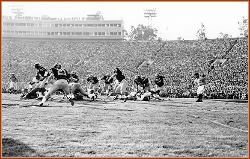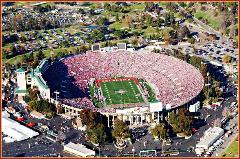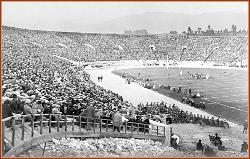



NC State's Carter-Finley Stadium
Carter-Finley Stadium was opened in 1966 as home to the North Carolina State
University Wolfpack football team. The stadium replaced the obsolete on-campus
Riddick Stadium and was originally named Carter Stadium in honor of Harry C. &
Wilbert J. "Nick" Carter, both graduates of the university. They were major contributors
to the original building of the stadium. The name of Albert E. Finley, another major
contributor to the University, was added later. While located on University land, the
stadium is a few miles to the west of the academic campus on Trinity Road just off of
Hillsborough Street. The capacity is approximately 60,000 seats. Carter-Finley Stadium
has been sold out for six straight years.
Finley Stadium was originally designed by architect Charles Kahn, a distinguished
professor in the NC State School of Design from 1959-1968. Kahn received his B.A.
from North Carolina in 1946, his Bachelors of Civil Engineering from North Carolina
State in 1948, his M.S. in Structures from M.I.T. in 1949, and his Bachelors in
Architecture from North Carolina State in 1956. Kahn was recruited by the University of
Kansas in 1968 to become the first Dean of their School of Architecture and Urban
Design. After closing out his tenure in academia in 1991, he has returned home to the
triangle and consults on architectural design and structural engineering projects.
The name 'Carter-Finley' honors Wilbert James (Nick) Carter (1902-1972) , Harry
Clifton Carter (1908-1990), and Albert Earle Finley (1895-1985). The two Carter
brothers graduated from NC State from the school of Textiles and became top
executives in the J. P. Stevens Company. They contributed several hundred thousand
dollars to fundraising for completion of the stadium. In 1937, the Carter brothers
formed their own company, Carter Fabrics of Greensboro, and merged with the J.P.
Stevens Corporation. The family was particularly involved with support of the NC State
school of textiles. NC State awarded an honorary Doctor of Textile Science degree to
Nick Carter in 1943.
Finley was also a strong supporter of the athletics program at NC State. After two years
of business school in Virginia, he became a stenographer for the Baltimore,
Chesapeake, and Atlantic Railroad Company, rapidly working his way from a position of
secretary to the general manager. Finley, a former US Army 2nd Lieutenant, soon
became involved in the sale of heavy construction equipment and eventually started
his own business, the Raleigh Tractor and Equipment Company. Finley kept an active
interest in supporting the college, and even donated a motel on Western Boulevard to
the Wolfpack Club to be used as an athletics dormitory.
Prior to the 2001 season, the university began a program of modernization of
Carter-Finley. The southern endzone was enclosed with seats, and the state-of-the-art
Murphy Center (named for Wendell Murphy) was built. Following the 2004-2005
football season, Carter-Finley was again expanded with the completion of the "Vaughn
Towers", a complex of luxury boxes, club seats, and media facilities which opened for
the 2005-2006 football season.
For the 2006 season, a new north end zone grandstand has been added. 5,730 new
chairback, bench and handicap-accessible seating, with another 1,630 permanent
bleacher seats built underneath the video scoreboard make Carter-Finley a bowl and
give it a capacity of 60,000 spectators. Additional upgrades to the stadium include a
new north endzone plaza with concession stands and the addition of two video screens
in each corner of the south endzone.
Retired jerseys on the facade of Carter-Finley Stadium includes those of Roman
Gabriel, Torry Holt and Philip Rivers. Carter-Finley also displays banners from NC
State's Bowl appearances which include the Gator Bowl, Peach Bowl, and Liberty Bowl.








